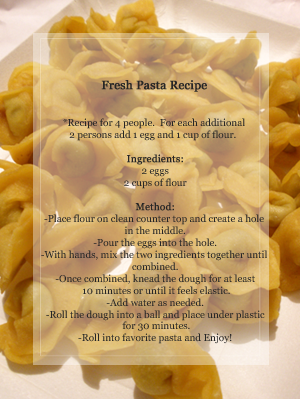

Visuals and text
by Audrey Sherman
The ingredients are few, the recipe simple and not found within the constraints of a bound book. Instead the inspiration for this dish stems from the collection of seasonally cultivated produce, grains, and meats Maria Emrichetta Pompili - Keti to her friends - purchases each morning and places in baskets around the kitchen in her Cagli restaurant Alimentare.
"I create all of my recipes by respecting what is in season and the local traditions," says Pompili, a proponent of the Slow Food Movement, which was born in Italy and is gaining momentum everywhere.
"Slow Food Movement" refers to living an unhurried life, beginning at the table, and uses the slogan "Good, clean, and right" to promote its message, says Pompili. In recent years members of the food industry in this small mountain community have begun banding together to reinforce the tradition of locally grown foods.

Keti in her kitchen.
Begun in Barolo, Italy, by Carlo Petrini in 1986, the movement promotes eco-gastronomy by using food that is good to eat, clean and without chemicals. The movement also treats the food producer fairly by ensuring that the person receives appropriate compensation, says Carlo Cleri, head of the Cagli chapter. Although anyone who respects the philosophy can become a Slow Food member, the Slow Food National Presidium must certify a product before it can use the group's label, Cleri says.
Members of the movement, which claims 85,000 followers worldwide, believe in the following: Sustaining the biodiversity of food products and local production, preserving the cultural identities of the local communities, educating others about the benefits of Slow Food, and working to connect producers with sellers.
Over 600 food products have been certified, including various types of grains, vegetables, and animals on the verge of extinction. Pompili is a fervent believer in the movement.
Working 12-hour shifts, six days a week, Pompili promotes these values through her cooking. She moves between ingredients, cookware, and the stove like any other chef dedicated to her craft, but a closer look at the ingredients reveals vast differences.

With customers at Alimentare.
With a menu that changes daily, she reproduces traditional recipes and creates her own, always respecting what is in season. Her favorite recipe is Vincisgrassi, a Cagliese dish that is similar to lasagna and made with prosciutto, chicken giblets, wine, and mushrooms - always from local sources.
Buying locally not only helps area producers, it is also environmentally friendly, Slow Food adherents believe, because it softens the impact of the food industry on the world's ecosystem.
"It is important to eat the food from your town because it is not ecological to transport it from far away as it leaves a huge carbon footprint," says Pompili. "By preserving the agriculture of the location, there are fewer kilometers, less pollution, and less cost," she adds.

Carlo Cleri tasting Salumi.
And there is another reason for choosing the Slow Food lifestyle, Pompili says – her appearance. She looks much younger than her 51 years and attributes her youthful glow to her Slow Food diet, which she began when she was 15.
While it is possible to follow the Slow Food guidelines daily at Alimentare, local members have been reaching out to educate other Cagliese residents, as well as trying to connect local producers with sellers.
One of the more successful ventures was a Slow Food-certified "salumi" festival, held in Cagli last April.
Offering up some of Italy's best quality salumi - the handcrafted cured pork sausages that are an Italian tradition - the event attracted over 40,000 people from across the world.
Different producers were chosen for the richness, variety, difference, and territorial specificity of the meat, says Cleri.
Cleri, who presented the event on national television, said that not only did Slow Food members attend but people who "are very interested in the quality of food."
Offering different workshops, free tastings, and cooking demonstrations, the festival introduced people to products that are beginning to vanish, he said. One such item is colonnata, a traditional delicacy produced by curing pig fat in a stone box with garlic, herbs, and sea salt for six to 10 months. It is usually served on toasted bread or polenta. Interest in colonnata has revived since its recipe appeared in the Slow Food cookbook, Cleri said.
The movement is important, says Cleri, as it is essential to preserve the knowledge or "sapere," that is becoming ruined by industrialization and the takeover of farms by large corporations.
"We are losing this experience, and it is important to save and sustain it," says Cleri. "It is important to me. My grandparents and parents were farmers, and I know how important it is to respect the earth."


![]()
